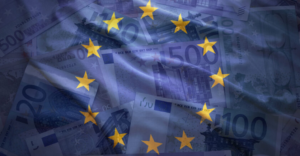
The widespread use of unmanned systems in Russia’s war against Ukraine represents not just a technological evolution, but a profound change in the logic of warfare, for which most European countries are not yet prepared, according to participants in the panel discussion “The Russia–Ukraine Drone War: Innovation on the Front Line and Beyond. What Can We Learn for Our Own Defense?” at the Ukraine Recovery Forum in Bucharest.
Panel VIa was moderated by Greg Melcher, Chief Operating Officer of the New Generation Warfare Centre (USA). The discussion was attended by Andriy Sirko-Galushchenko, an expert in the development of UAVs for military applications; Terry Jamison, International Director of Boeing’s Vertical Takeoff and Landing Aircraft Division; Mustafa Nayem, Director of Public Communications at GTX; former Prime Minister of Romania, retired General Nicolae Ciucă, and Deputy Chief of Staff for Operations and Training, Lieutenant General Julian Berdila.
According to the speakers, what until recently was perceived as a “distant technological horizon” has already become an everyday operational reality. The development of unmanned systems, open architectures, and the rapid integration of new capabilities indicate that the “future of warfare” has arrived much sooner than many Western players expected. Ukraine’s combat experience has shown that accelerated innovation cycles are leading to a structural transformation in the planning of air, ground, and joint operations.
Participants emphasized that the combined use of manned and unmanned platforms, as well as immediate technical interoperability between them, are becoming a basic requirement for the adaptation of modern armed forces. Drones are already being used systematically for reconnaissance, high-precision strikes, logistics, mining and demining, artillery fire correction, and special operations support. Massive coordinated attacks on critical infrastructure have demonstrated the limitations of purely reactive defense and highlighted the need to neutralize threats “at the source.”
At the same time, counter-drone systems are rapidly developing, combining existing surveillance and electronic warfare capabilities with new solutions to counter large numbers of small, low-altitude targets. “This is no longer an episodic tool, but a full-fledged layer of the modern battlefield that requires a separate doctrine, forces, and means,” Berdila noted.
A separate emphasis in the discussion was placed on Europe’s vulnerability to hybrid forms of aggression. According to experts, traditional threat assessments do not correspond to the realities in which the enemy acts mainly with asymmetric, scattered, and difficult-to-attribute methods. Incidents involving the appearance of unknown drones near critical infrastructure in various European countries, they said, expose the gap between public perception, the level of institutional preparedness, and the actual nature of the risks.
Following the discussion, the participants concluded that “drone” warfare is not only a technical issue but also a challenge for institutional capacity and defense planning. Adapting to the new operational environment requires flexible institutions, short innovation cycles, coordinated investments, and a doctrine capable of quickly integrating the lessons learned from Ukraine’s experience. Modern warfare, they emphasized, has become a space where speed of adaptation, integration of systems, and simultaneous readiness for offensive and defensive actions are key elements of strategic resilience.
The forum “Rebuilding Ukraine: Security, Opportunities, Investments” is being held on December 11-12 in Bucharest under the auspices of the Romanian Ministry of Foreign Affairs and the Ukrainian Ministry of Foreign Affairs and organized by the New Strategy Center. According to the organizers, more than 30 panel discussions and parallel sessions are planned over two days with the participation of representatives of governments, international organizations, the private sector, financial institutions, and experts from Europe, North America, and Asia. The topics of the panels cover security and defense, infrastructure, financing and investment, green energy, digitalization, human capital, and cross-border cooperation.

A new analysis of GRACE/GRACE-FO satellite data for 2002–2024, published by The Guardian, has revealed a steady decline in freshwater reserves in Southern and Central Europe. This applies not only to rivers and lakes, but also to soil moisture, snow, glaciers, and groundwater, which have traditionally been considered a more stable source.
From Spain and Italy to Poland and Ukraine, there is a negative trend in the “water balance” — water losses exceed replenishment.
Against the backdrop of the pan-European trend, Ukraine faces several specific risk factors at once. Scientific studies on water security in Ukraine note an increase in climate risks – from droughts to flash floods. Water shortages are already causing significant economic losses, primarily in agriculture, and are intensifying as temperatures rise and precipitation patterns change.
A joint document by experts and environmental movements on irrigation warns that if current trends continue, most of the territory could effectively turn into a single arid zone similar to the current steppe. Without modern irrigation systems, it will be impossible to grow major crops in the south, and droughts are increasingly being recorded even in the central and western regions.
The destruction of the Kakhovka hydroelectric dam in June 2023 devastated the country’s largest reservoir, which provided up to 40% of the water consumption in southern Ukraine, including drinking water supply, industry, and irrigation. Scientific assessments indicate a sharp deterioration in water supply to southern regions in the context of the existing climate drought.
Further research has revealed a long-term “toxic” effect: tens of thousands of tons of heavy metals and pollutants have begun to be released from bottom sediments, posing long-term risks to the rivers and ecosystems of the lower Dnipro and the Black Sea.
A number of communities in the south and east of the country, especially in the combat zone, are already experiencing local “water crises” – from interruptions in drinking water supply to problems with water supply for irrigation and industry. Military destruction exacerbates the overall climate trend towards scarcity.
Ukraine has formally recognized water as one of the key priorities for climate adaptation. Water management is being transferred to a basin-based approach following the European model: the Dnieper basin management plan was developed with EU support and is being used as a template for the country’s eight other river basins. Agricultural policy until 2030 specifically stipulates the development of water supply systems for irrigation, the transition to climate-oriented agriculture, and more efficient water use.
However, there remains a large gap between the strategies on paper and the actual state of the networks, canals, wells, and treatment facilities. In the context of war, the resources of the state and local communities are limited, while demand for water—from the agricultural sector to IDPs and frontline cities—is growing.
Against the backdrop of Europe-wide “drying up” and the trend identified in the study towards the depletion of water resources in Central and Eastern Europe, including Ukraine, the country is effectively under double pressure: climatic and military.
Water is becoming not only a resource but also an element of national security. This means that water infrastructure, groundwater protection, and restoration after the destruction of the Kakhovka Hydroelectric Power Plant must be placed on a par with energy security and defense. Recovery and European integration projects must include a rigorous “water check” — from new agricultural programs to industrial policy. International funding for reconstruction and climate adaptation should logically be linked to reforms in water management, transparency of water use, and modernization of irrigation, especially in the southern regions.
Satellite data on the “drying up” of Europe is transforming the issue of water in Ukraine from a background issue to one of the key issues for the future – from harvests and exports to population density and climate resilience.

Contributions to supplementary pension schemes are still not made by 41% of Europeans, according to the results of a survey by the European Association of Insurers Insurance Europe, according to its website.
“Despite the growing awareness of the need to save, 41% of Europeans still do not contribute to supplementary pension schemes, with national rates ranging from 16% to 65%,” the information said.
According to the information, the fourth edition of the survey, which covered 12,700 respondents from 12 markets (Austria, Belgium, Finland, France, Germany, Greece, Hungary, Ireland, Italy, Luxembourg, Spain and Switzerland), confirms that a growing proportion of people are aware of the importance of saving, but financial pressures, information gaps and behavioral factors still prevent many from taking action. Women, the unemployed and workers in non-standard jobs remain disproportionately affected.
The gender gap also persists, with the proportion of those not saving reaching 46% for women compared to 35% for men.
Advice remains a crucial incentive to act: 31% of respondents started saving after being advised by an intermediary or adviser, while 25% started through employer schemes or automatic enrollment. Public awareness campaigns motivated only 3%.
Security remains the top priority for European savers, with 81% of savers favoring products that guarantee at least their capital. Women are even more security-oriented, with 85% preferring capital protection compared to 77% of men. Only 19% of respondents prefer higher risk options in pursuit of higher returns.
“With demographic pressures rising in Europe, the survey highlights the growing risk of insufficient retirement income and over-reliance on public pension schemes. It shows that personalized advice and tools such as pension tracking systems are key to turning awareness into action,” highlights Insurance Europe.

Prices for RAM in Europe and the US have risen significantly, negatively affecting the electronics and computer market. In Ukraine and neighboring countries, this trend is already beginning to take effect, although there is little accurate domestic data available yet.
According to Reuters, Samsung Electronics raised its contract prices for 64 GB and 96 GB DDR5 modules by more than 30% between September and November 2025.
Analysts at Counterpoint Technology Market Research note that global prices for some DRAM chips have risen 3-11 times since the beginning of 2025.
The GameGPU portal reports that in Europe, a 64 GB DDR5 kit sells for around €550, which is significantly higher than the usual level.
TrendForce predicts that memory prices could rise another 30% in the fourth quarter of 2025 and another 20% in early 2026.
There are no accurate statistics for Ukraine at the time of publication, but retailers and dealers note that prices for 64 GB DDR5 kits have risen by tens of percent in recent months.
The increase in memory costs leads to higher prices for computers, laptops, game consoles, and servers. There is already information that manufacturers and sellers in the EU are preparing significant price adjustments for models with high memory capacities.

In September 2025, Express Insurance settled insurance claims under comprehensive insurance policies in Austria, Belgium, Bulgaria, Great Britain, Spain, Italy, Moldova, Germany, Poland, Romania, Turkey, Hungary, France, Croatia, the Czech Republic, and Switzerland for a total amount of UAH 4.7 million, according to the insurer’s website.
In particular, in Turkey, sudden braking on the highway led to losses of more than UAH 740,000, compensation for a careless maneuver in France amounted to UAH 528,000, and the sudden appearance of a wild boar on an evening highway in Spain amounted to more than UAH 351,000.
A payment of UAH 284,000 was made for damage to a car while parking in Croatia, and UAH 119,000 for an unnoticed obstacle in Austria when driving into an underground bumper.
Express Insurance LLC was founded in 2008 with the participation of Ukravto Group.
The company is represented in more than 60 points of sale throughout Ukraine and is actively expanding its network of partner service stations. Today, the number of service station partners exceeds 100.

High prices for berries in the 2025 season were caused by spring frosts, which damaged 20-50% of the crop in a number of regions of Ukraine, as well as global market conditions, said Taras Bashtannik, president of the Ukrainian Fruit and Vegetable Association (UFVA).
“If we talk about prices in 2025, losses for all major berry items ranged from 20-50%, primarily due to spring frosts. All major exporting countries of the main items – strawberries, raspberries, blueberries, and cherries – also suffered crop losses,” he said at the Agro2Food exhibition.
The head of the association noted that high product prices allowed producers to compensate for the final financial result.
Bashkanik recalled that during the years of war, Ukrainian berry farming lost a lot of production areas, in particular in the Kherson and Mykolaiv regions, where early berries were grown.
“We can only state that, for example, from 2022 to the present, many perennial plantations have been planted, including 3,800 hectares under the state grant program. And without state assistance, we are talking about 4,500-5,000 hectares. In total, berry growing is currently carried out on 17-20 thousand hectares,” said the head of the UPOA.
According to the expert’s estimate, 95% of all raspberries grown in Ukraine are currently processed, mainly for freezing. At the same time, 95% of this product is exported.
“From 2017 to 2025, Ukraine has gone from being a net importer or having a zero import-export balance of frozen raspberries to becoming the largest exporter of frozen raspberries in Europe,” said Bashtannik.
According to his information, no more than 5% of cultivated blueberries in Ukraine are processed. The rest is mostly exported fresh for economic reasons. However, there is a rapid global trend in this crop: in the US, 50% of blueberries are processed, and in Europe, 30%. In Ukraine, this figure is approaching 30%.
In Ukraine, 25-30% of the gross harvest of garden strawberries is processed. Almost the entire volume of processed products remains in Ukraine for domestic consumption.
“Unfortunately, we have to admit that Ukraine, as a producer and exporter of frozen strawberries, has no place in Europe and the world, given the costs and prices offered by Morocco, Egypt, Tunisia, and China,” said the expert.
Speaking about the production of jams and preserves, Bashtannik noted that craft production dominates this segment. Its products are sufficient to meet the needs of HoReCa, while retail mostly covers the needs of Ukrainians through imports. The production of several powerful domestic players is not enough to meet the needs of supermarket shoppers.
“If we don’t take into account any black swans that may or may not appear, the expectations for 2026 in the industry are positive. Ukraine will continue to increase its presence in the European market for fresh and processed berries. Despite the labor shortage, we look more attractive in terms of cost compared to European countries. Therefore, we will take market share from countries that have traditionally dominated the European market. These are Poland and Serbia, first and foremost,” summarized the head of the UPOA.